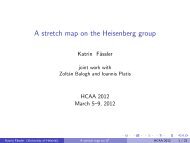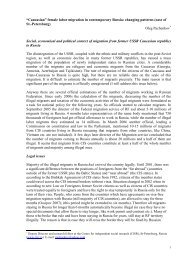THORIUM AS AN ENERGY SOURCE - Opportunities for Norway ...
THORIUM AS AN ENERGY SOURCE - Opportunities for Norway ...
THORIUM AS AN ENERGY SOURCE - Opportunities for Norway ...
Create successful ePaper yourself
Turn your PDF publications into a flip-book with our unique Google optimized e-Paper software.
Thorium as an Energy Source - <strong>Opportunities</strong> <strong>for</strong> <strong>Norway</strong><br />
10. ECONOMICAL <strong>AS</strong>PECTS<br />
Due to the lack of data, it seems impractical to develop meaningful cost projections <strong>for</strong> any<br />
nuclear energy systems using thorium. Historical examples give some ideas of the funding that<br />
may be required. For example, in the 1970s, Germany spent around 500 millions euros in current<br />
money to develop a thorium fuel cycle and 2.5 billions euros <strong>for</strong> the high temperature reactor<br />
itself. More recently, the GIF in its technology roadmap to develop Generation IV advanced<br />
nuclear energy systems estimated at around one billion dollars the funds needed to assess the<br />
viability and the per<strong>for</strong>mance of one system be<strong>for</strong>e any decision to develop and build a<br />
demonstrator, which of course would require large additional funding.<br />
However some insights may be given regarding thorium as raw material and a comparison<br />
between conventional reactors and Accelerator Driven System (ADS).<br />
Regarding the raw material, ores or concentrates of oxide of thorium, there is a small market<br />
supplying companies processing thorium <strong>for</strong> non-energy uses such as high-temperature ceramics,<br />
crucibles, catalysts, welding electrodes and some specific alloys. However, the use of thorium in<br />
most of these products has continuously decreased due to the burden associated with its natural<br />
radioactivity, encouraging processors to switch to non radioactive materials where possible.<br />
A nearly constant commercial price in the range 30 - 35 US$/kg was published in the 1960s and<br />
1970s, and due to the decrease of demand this publication was suspended. Fluctuations in the<br />
price of thorium have been minimized by its by-product status and a supply that far exceeds<br />
demand. In practice, today, many countries have fairly large stockpiles of thorium that they<br />
consider as waste.<br />
If thorium was to be considered as raw material <strong>for</strong> energy production in the future, a more<br />
substantial market would develop. The raw material contribution to the cost of the electricity<br />
generated will remain very low comparable with or lower than that <strong>for</strong> the uranium cycle.<br />
There is little in<strong>for</strong>mation available regarding the capital cost of an ADS and nothing referring<br />
specifically to a thorium fuelled ADS. In 1997, the Euratom Scientific and Technical Committee<br />
(STC), the highest level advisory committee <strong>for</strong> nuclear research in the European institutions,<br />
was requested by the European Commission to evaluate the proposals <strong>for</strong> a nuclear energy<br />
amplifier system <strong>for</strong> electricity generation. The STC expressed a strong opinion (ref. Report<br />
EUR17616 EN): The STC not only questioned the complexity of an ADS (“The STC does not<br />
consider it is realistic to pursue development of the whole system at once” and “sees significant<br />
technological and commercial risks in almost every aspect of the proposals“), but was also<br />
convinced that <strong>for</strong> electricity production an ADS “would not be economically competitive with the<br />
improved light water reactor systems now under development, such as the EPR”. The STC<br />
concluded that further work on ADS should be primarily aimed at waste management (actinides<br />
burning) rather than at energy production.<br />
A comparative study between ADS and Fast Reactors (FRs) in advanced nuclear fuel cycles was<br />
issued in 2002 by OECD/NEA [106]. This study was carried out by a group of more than 35<br />
experts from 15 OECD countries including all the major players in the nuclear field and 3<br />
international organizations. Although this study was primarily focused on fuel cycle schemes to<br />
reduce the long term radiotoxic inventory of waste, some economic aspects were looked at. The<br />
expert group considered that a possible cost reduction of a sub-critical reactor compared to a<br />
94

















